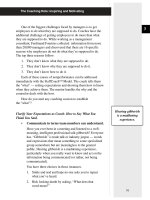Designing and Managing Integrated Marketing Channels pps
Bạn đang xem bản rút gọn của tài liệu. Xem và tải ngay bản đầy đủ của tài liệu tại đây (209.93 KB, 19 trang )
Designing and Managing
Integrated
Marketing Channels
Marketing Management, 13
th
ed
15
Copyright © 2009 Pearson Education, Inc. Publishing as Prentice Hall
15-2
Chapter Questions
•
What is a marketing channel system and
value network?
•
What work do marketing channels perform?
•
How should channels be designed?
•
What decisions do companies face in
managing their channels?
•
How should companies integrate channels
and manage channel conflict?
•
What are the key issues with e-commerce?
Copyright © 2009 Pearson Education, Inc. Publishing as Prentice Hall
15-3
What is a Marketing Channel?
A marketing channel system is the
particular set of interdependent
organizations involved in the process of
making a product or service available
for use or consumption.
Copyright © 2009 Pearson Education, Inc. Publishing as Prentice Hall
15-4
Channels and
Marketing Decisions
•
A push strategy uses the manufacturer’s
sales force, trade promotion money, and
other means to induce intermediaries to
carry, promote, and sell the product to end
users
•
A pull strategy uses advertising, promotion,
and other forms of communication to
persuade consumers to demand the product
from intermediaries
Copyright © 2009 Pearson Education, Inc. Publishing as Prentice Hall
15-5
Buyer Expectations for
Channel Integration
•
Ability to order a product online and pick it up
at a convenient retail location
•
Ability to return an online-ordered product to
a nearby store
•
Right to receive discounts based on total
online and offline purchases
Copyright © 2009 Pearson Education, Inc. Publishing as Prentice Hall
15-6
Categories of Buyers
•
Habitual shoppers
•
High value deal seekers
•
Variety-loving shoppers
•
High-involvement shoppers
Copyright © 2009 Pearson Education, Inc. Publishing as Prentice Hall
15-7
Types of Shoppers
•
Service/quality customers
•
Price/value customers
•
Affinity customers
Copyright © 2009 Pearson Education, Inc. Publishing as Prentice Hall
15-8
Channel Member Functions
•
Gather information
•
Develop and disseminate persuasive
communications
•
Reach agreements on price and terms
•
Acquire funds to finance inventories
•
Assume risks
•
Provide for storage
•
Provide for buyers’ payment of their bills
•
Oversee actual transfer of ownership
Copyright © 2009 Pearson Education, Inc. Publishing as Prentice Hall
15-9
Designing a
Marketing Channel System
•
Analyze customer needs
•
Establish channel objectives
•
Identify major channel alternatives
•
Evaluate major channel alternatives
Copyright © 2009 Pearson Education, Inc. Publishing as Prentice Hall
15-10
Channel Service Outputs
•
Lot size
•
Waiting/delivery time
•
Spatial convenience
•
Product variety
•
Service backup
Copyright © 2009 Pearson Education, Inc. Publishing as Prentice Hall
15-11
Identifying Channel Alternatives
•
Types of intermediaries
•
Number of intermediaries
•
Terms and responsibilities
Copyright © 2009 Pearson Education, Inc. Publishing as Prentice Hall
15-12
Number of Intermediaries
•
Exclusive
•
Selective
•
Intensive
Copyright © 2009 Pearson Education, Inc. Publishing as Prentice Hall
15-13
Terms and Responsibilities
of Channel Members
•
Price policy
•
Condition of sale
•
Distributors’ territorial rights
•
Mutual services and responsibilities
Copyright © 2009 Pearson Education, Inc. Publishing as Prentice Hall
15-14
Channel-Management Decisions
•
Selecting channel members
•
Training channel members
•
Motivating channel members
•
Evaluating channel members
•
Modifying channel members
Copyright © 2009 Pearson Education, Inc. Publishing as Prentice Hall
15-15
Channel Power
•
Coercive
•
Reward
•
Legitimate
•
Expert
•
Referent
Copyright © 2009 Pearson Education, Inc. Publishing as Prentice Hall
15-16
Channel Integration and Systems
Vertical marketing systems
•
Corporate VMS
•
Administered VMS
•
Contractual VMS
Horizontal marketing systems
Multichannel systems
Copyright © 2009 Pearson Education, Inc. Publishing as Prentice Hall
15-17
What is Channel Conflict?
•
Channel conflict occurs when one
member’s actions prevent another
channel from achieving its goal.
•
Types of channel conflict
•
Vertical
•
Horizontal
•
Multichannel
Copyright © 2009 Pearson Education, Inc. Publishing as Prentice Hall
15-18
Causes of Channel Conflict
•
Goal incompatibility
•
Unclear roles and rights
•
Differences in perception
•
Intermediaries’ dependence on
manufacturer
Copyright © 2009 Pearson Education, Inc. Publishing as Prentice Hall
15-19
Table 15.3 Strategies for Managing
Channel Conflict
•
Adoption of
superordinate goals
•
Exchange of
employees
•
Joint membership in
trade associations
•
Cooptation
•
Diplomacy
•
Mediation
•
Arbitration
•
Legal recourse









